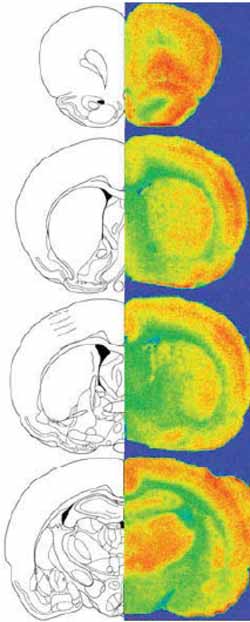Childhood trauma leaves its mark on the brain

Peripuberty stressed rats show increased activation in the amygdala (involved in emotional processing) and blunted activation in the orbitofrontal cortex (involved in social decision-making).<br><br>Credit: EPFL<br>
It is well known that violent adults often have a history of childhood psychological trauma. Some of these individuals exhibit very real, physical alterations in a part of the brain called the orbitofrontal cortex. Yet a direct link between such early trauma and neurological changes has been difficult to find, until now.
Publishing in the January 15 edition of Translational Psychiatry, EPFL Professor Carmen Sandi and team demonstrate for the first time a correlation between psychological trauma in pre-adolescent rats and neurological changes similar to those found in violent humans.
“This research shows that people exposed to trauma in childhood don't only suffer psychologically, but their brain also gets altered,” explains Sandi, Head of EPFL's Laboratory of Behavioral Genetics, Director of the Brain Mind Institute, and a member of the National Centers for Competence in Research SYNAPSY. “This adds an additional dimension to the consequences of abuse, and obviously has scientific, therapeutic and social implications.”
The researchers were able to unravel the biological foundations of violence using a cohort of male rats exposed to psychologically stressful situations when young. After observing that these experiences led to aggressive behavior when the rats reached adulthood, they examined what was happening in the animals' brains to see if the traumatic period had left a lasting mark.
“In a challenging social situation, the orbitofrontal cortex of a healthy individual is activated in order to inhibit aggressive impulses and to maintain normal interactions,” explains Sandi. “But in the rats we studied, we noticed that there was very little activation of the orbitofrontal cortex. This, in turn, reduces their ability to moderate their negative impulses. This reduced activation is accompanied by the overactivation of the amygdala, a region of the brain that's involved in emotional reactions.” Other researchers who have studied the brains of violent human individuals have observed the same deficit in orbitofrontal activation and the same corresponding reduced inhibition of aggressive impulses. “It's remarkable; we didn't expect to find this level of similarity,” says Sandi.
The scientists also measured changes in the expression of certain genes in the brain. They focused on genes known to be involved in aggressive behavior for which there are polymorphisms (genetic variants) that predispose carriers to an aggressive attitude, and they looked at whether the psychological stress experienced by the rats caused a modification in the expression of these genes. “We found that the level of MAOA gene expression increased in the prefrontal cortex,” says Sandi. This alteration was linked to an epigenetic change; in other words, the traumatic experience ended up causing a long-term modification of this gene's expression.
Finally, the researchers tested the efficacy of an MAOA gene inhibitor, in this case an anti-depressant, to see if it could reverse the rise in aggression induced by juvenile stress, which it did. Going forward, the team will explore treatments for reversing physical changes in the brain, and above all, attempt to shed light on whether some people are more vulnerable to being effected by trauma based on their genetic makeup.
“This research could also reveal the possible ability of antidepressants—an ability that's increasingly being suspected—to renew cerebral plasticity,” says Sandi.
More Info
The NCCR “SYNAPSY – Synaptic Bases of Mental Diseases” aims to discover the neurobiological mechanisms of mental and cognitive disorders, since one of the major challenges in psychiatry is to achieve a better understanding of how these illnesses originate. It focuses on the interface between preclinical research and clinical development, combining neuroscience with psychiatry. It is hosted at EPFL and funded by the Swiss national science foundation.
Researcher Contact
Carmen Sandi, EPFL researcher, +41 693 95 35 or carmen.sandi@epfl.ch
Media Contact
More Information:
http://www.epfl.chAll latest news from the category: Life Sciences and Chemistry
Articles and reports from the Life Sciences and chemistry area deal with applied and basic research into modern biology, chemistry and human medicine.
Valuable information can be found on a range of life sciences fields including bacteriology, biochemistry, bionics, bioinformatics, biophysics, biotechnology, genetics, geobotany, human biology, marine biology, microbiology, molecular biology, cellular biology, zoology, bioinorganic chemistry, microchemistry and environmental chemistry.
Newest articles

Properties of new materials for microchips
… can now be measured well. Reseachers of Delft University of Technology demonstrated measuring performance properties of ultrathin silicon membranes. Making ever smaller and more powerful chips requires new ultrathin…

Floating solar’s potential
… to support sustainable development by addressing climate, water, and energy goals holistically. A new study published this week in Nature Energy raises the potential for floating solar photovoltaics (FPV)…

Skyrmions move at record speeds
… a step towards the computing of the future. An international research team led by scientists from the CNRS1 has discovered that the magnetic nanobubbles2 known as skyrmions can be…





















